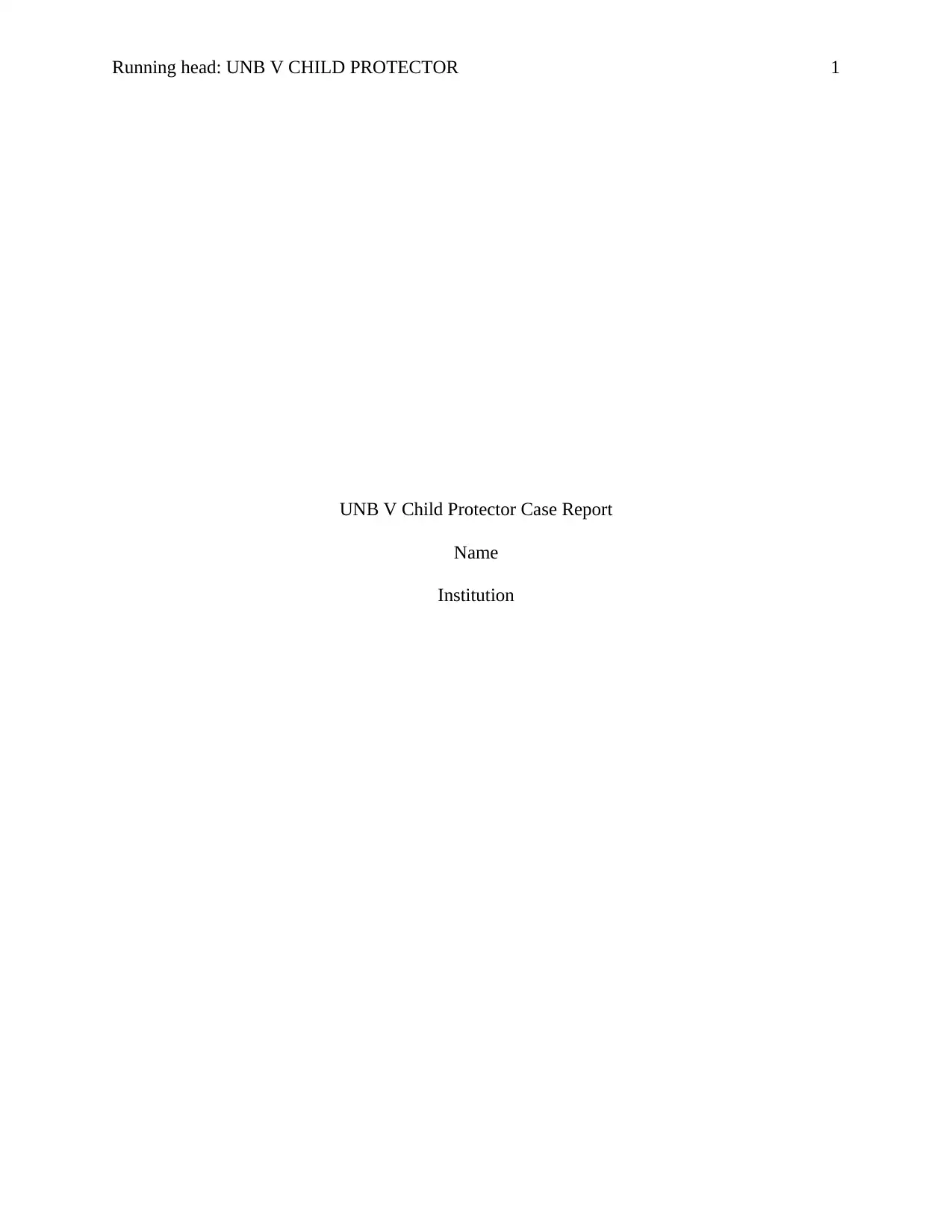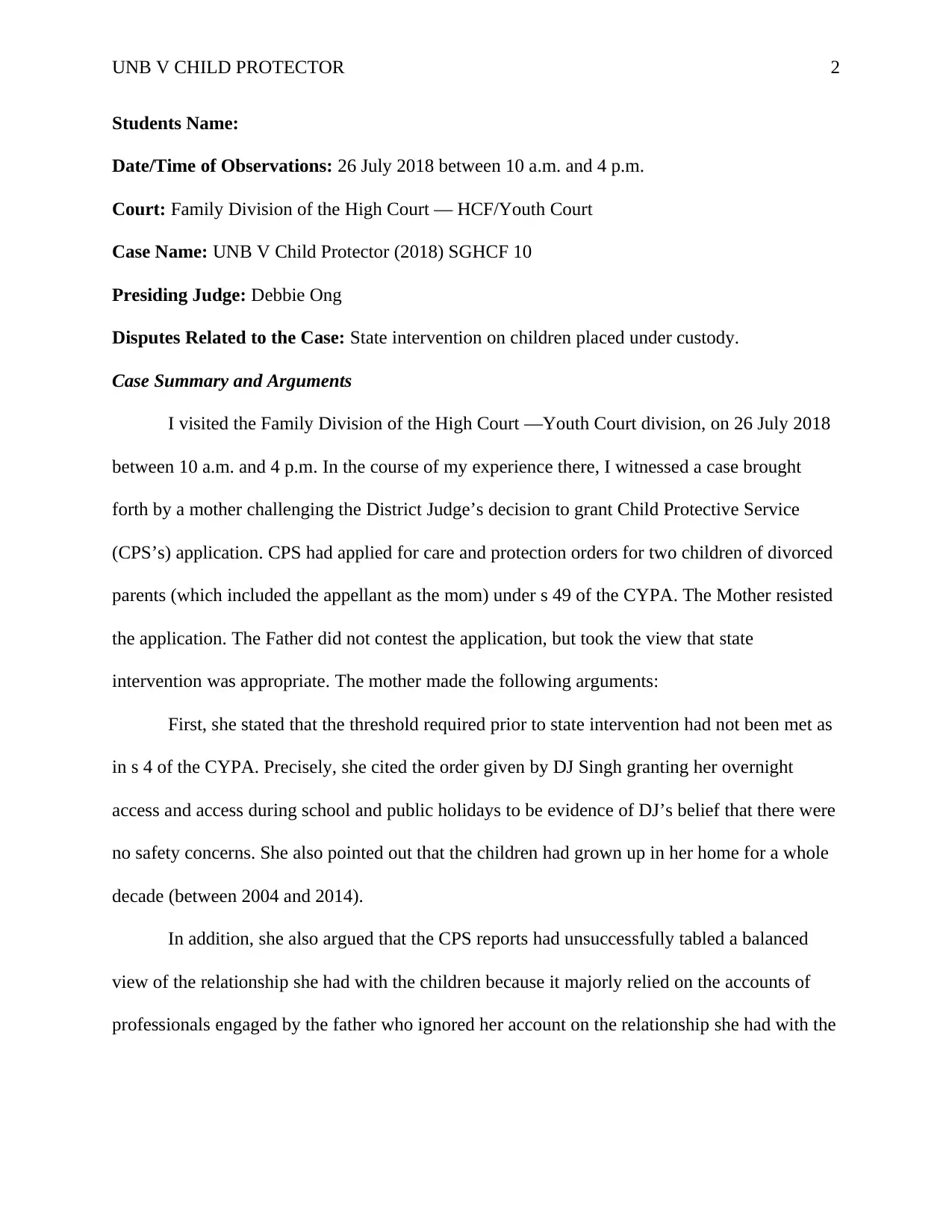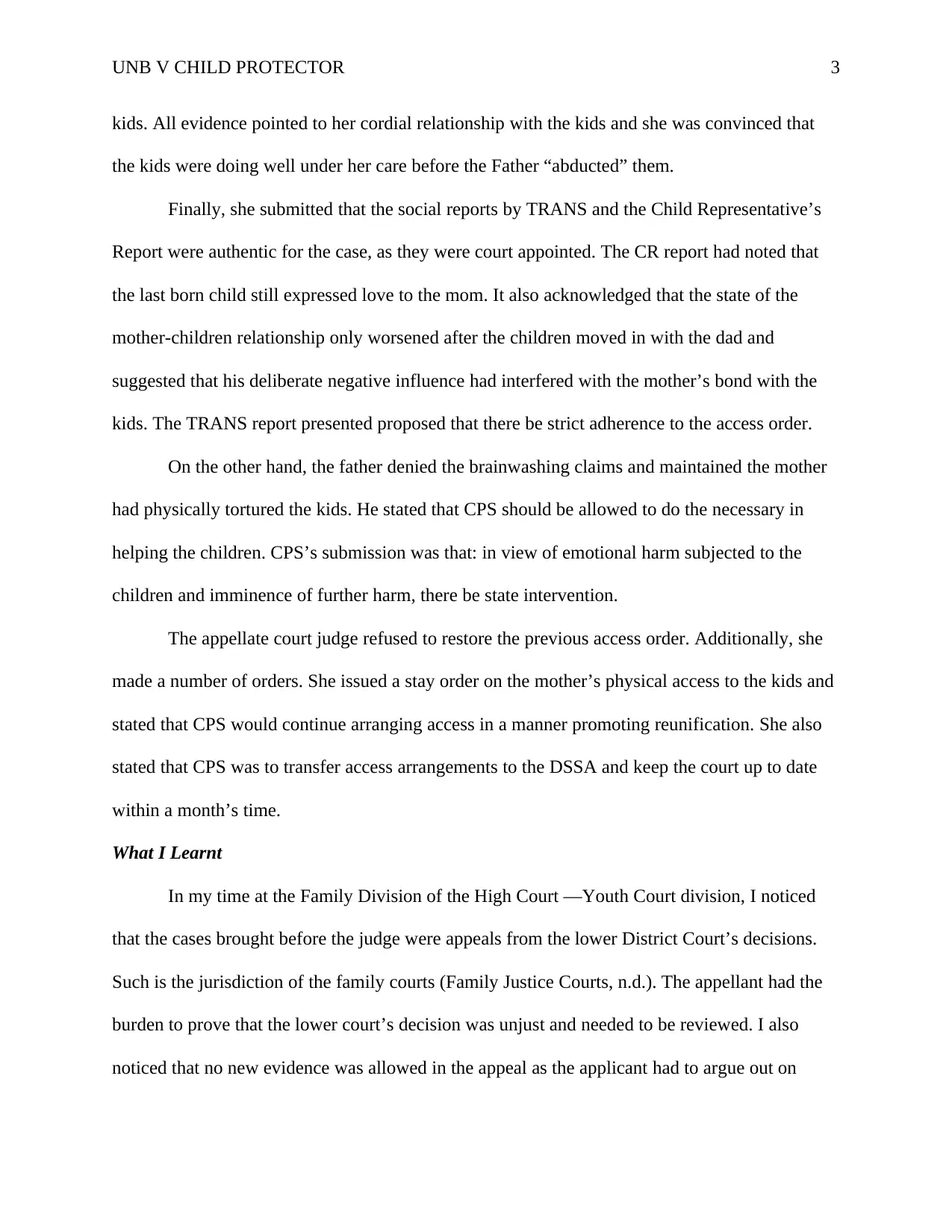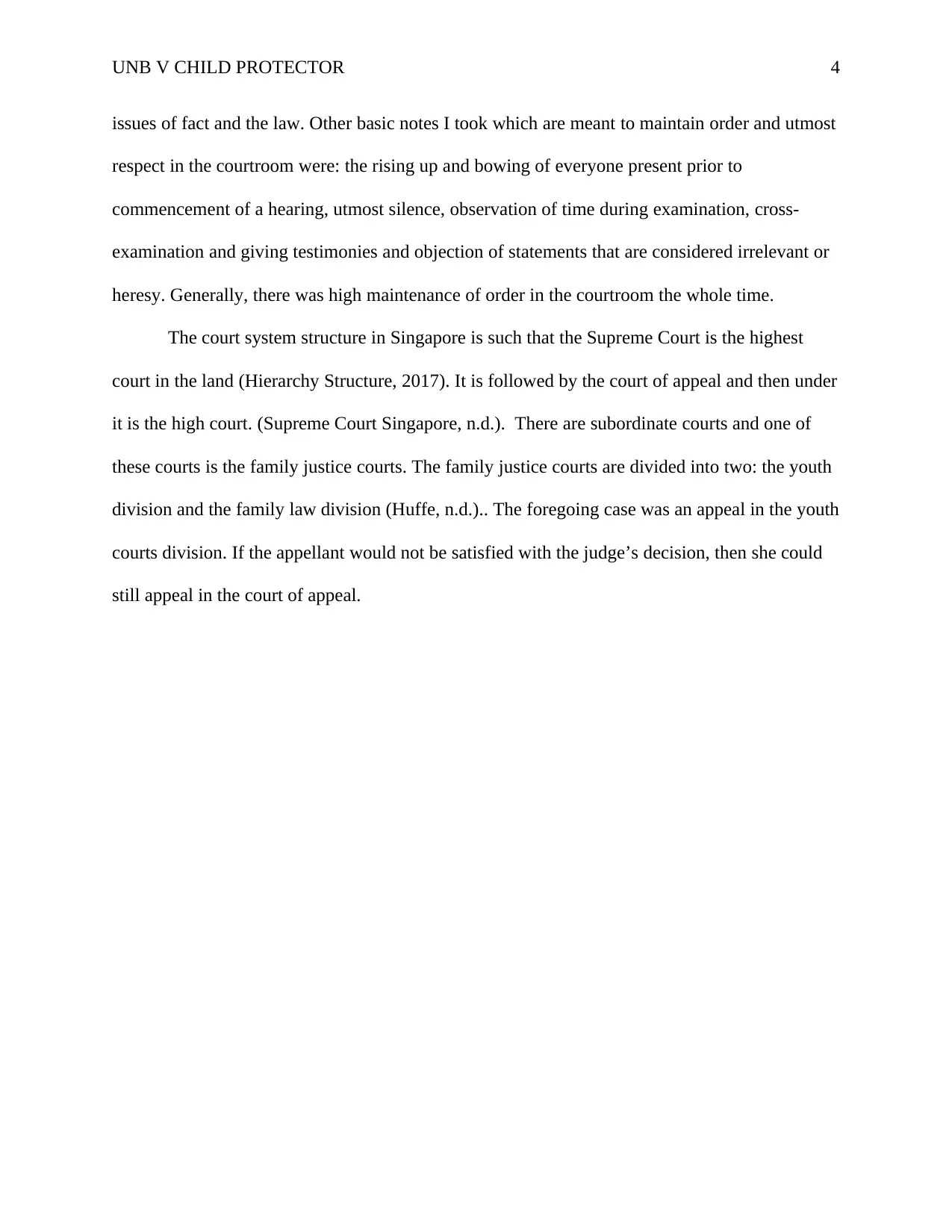UNB V Child Protector: Examining State Intervention in Child Custody
VerifiedAdded on 2023/06/08
|5
|1039
|380
Case Study
AI Summary
This case study provides an analysis of the UNB V Child Protector case heard in the Family Division of the High Court in Singapore. The case involves a mother appealing a District Judge's decision to grant Child Protective Services (CPS) care and protection orders for her two children. The mother argued that the threshold for state intervention was not met, citing evidence of a cordial relationship with her children and questioning the balance of CPS reports. The father maintained allegations of physical abuse, supporting CPS intervention. The appellate court judge issued a stay order on the mother's physical access, directing CPS to arrange access promoting reunification and update the court. The case highlights the complexities of child custody disputes, state intervention, and the burden of proof in family court appeals within the Singaporean legal system.

Running head: UNB V CHILD PROTECTOR 1
UNB V Child Protector Case Report
Name
Institution
UNB V Child Protector Case Report
Name
Institution
Paraphrase This Document
Need a fresh take? Get an instant paraphrase of this document with our AI Paraphraser

UNB V CHILD PROTECTOR 2
Students Name:
Date/Time of Observations: 26 July 2018 between 10 a.m. and 4 p.m.
Court: Family Division of the High Court — HCF/Youth Court
Case Name: UNB V Child Protector (2018) SGHCF 10
Presiding Judge: Debbie Ong
Disputes Related to the Case: State intervention on children placed under custody.
Case Summary and Arguments
I visited the Family Division of the High Court —Youth Court division, on 26 July 2018
between 10 a.m. and 4 p.m. In the course of my experience there, I witnessed a case brought
forth by a mother challenging the District Judge’s decision to grant Child Protective Service
(CPS’s) application. CPS had applied for care and protection orders for two children of divorced
parents (which included the appellant as the mom) under s 49 of the CYPA. The Mother resisted
the application. The Father did not contest the application, but took the view that state
intervention was appropriate. The mother made the following arguments:
First, she stated that the threshold required prior to state intervention had not been met as
in s 4 of the CYPA. Precisely, she cited the order given by DJ Singh granting her overnight
access and access during school and public holidays to be evidence of DJ’s belief that there were
no safety concerns. She also pointed out that the children had grown up in her home for a whole
decade (between 2004 and 2014).
In addition, she also argued that the CPS reports had unsuccessfully tabled a balanced
view of the relationship she had with the children because it majorly relied on the accounts of
professionals engaged by the father who ignored her account on the relationship she had with the
Students Name:
Date/Time of Observations: 26 July 2018 between 10 a.m. and 4 p.m.
Court: Family Division of the High Court — HCF/Youth Court
Case Name: UNB V Child Protector (2018) SGHCF 10
Presiding Judge: Debbie Ong
Disputes Related to the Case: State intervention on children placed under custody.
Case Summary and Arguments
I visited the Family Division of the High Court —Youth Court division, on 26 July 2018
between 10 a.m. and 4 p.m. In the course of my experience there, I witnessed a case brought
forth by a mother challenging the District Judge’s decision to grant Child Protective Service
(CPS’s) application. CPS had applied for care and protection orders for two children of divorced
parents (which included the appellant as the mom) under s 49 of the CYPA. The Mother resisted
the application. The Father did not contest the application, but took the view that state
intervention was appropriate. The mother made the following arguments:
First, she stated that the threshold required prior to state intervention had not been met as
in s 4 of the CYPA. Precisely, she cited the order given by DJ Singh granting her overnight
access and access during school and public holidays to be evidence of DJ’s belief that there were
no safety concerns. She also pointed out that the children had grown up in her home for a whole
decade (between 2004 and 2014).
In addition, she also argued that the CPS reports had unsuccessfully tabled a balanced
view of the relationship she had with the children because it majorly relied on the accounts of
professionals engaged by the father who ignored her account on the relationship she had with the

UNB V CHILD PROTECTOR 3
kids. All evidence pointed to her cordial relationship with the kids and she was convinced that
the kids were doing well under her care before the Father “abducted” them.
Finally, she submitted that the social reports by TRANS and the Child Representative’s
Report were authentic for the case, as they were court appointed. The CR report had noted that
the last born child still expressed love to the mom. It also acknowledged that the state of the
mother-children relationship only worsened after the children moved in with the dad and
suggested that his deliberate negative influence had interfered with the mother’s bond with the
kids. The TRANS report presented proposed that there be strict adherence to the access order.
On the other hand, the father denied the brainwashing claims and maintained the mother
had physically tortured the kids. He stated that CPS should be allowed to do the necessary in
helping the children. CPS’s submission was that: in view of emotional harm subjected to the
children and imminence of further harm, there be state intervention.
The appellate court judge refused to restore the previous access order. Additionally, she
made a number of orders. She issued a stay order on the mother’s physical access to the kids and
stated that CPS would continue arranging access in a manner promoting reunification. She also
stated that CPS was to transfer access arrangements to the DSSA and keep the court up to date
within a month’s time.
What I Learnt
In my time at the Family Division of the High Court —Youth Court division, I noticed
that the cases brought before the judge were appeals from the lower District Court’s decisions.
Such is the jurisdiction of the family courts (Family Justice Courts, n.d.). The appellant had the
burden to prove that the lower court’s decision was unjust and needed to be reviewed. I also
noticed that no new evidence was allowed in the appeal as the applicant had to argue out on
kids. All evidence pointed to her cordial relationship with the kids and she was convinced that
the kids were doing well under her care before the Father “abducted” them.
Finally, she submitted that the social reports by TRANS and the Child Representative’s
Report were authentic for the case, as they were court appointed. The CR report had noted that
the last born child still expressed love to the mom. It also acknowledged that the state of the
mother-children relationship only worsened after the children moved in with the dad and
suggested that his deliberate negative influence had interfered with the mother’s bond with the
kids. The TRANS report presented proposed that there be strict adherence to the access order.
On the other hand, the father denied the brainwashing claims and maintained the mother
had physically tortured the kids. He stated that CPS should be allowed to do the necessary in
helping the children. CPS’s submission was that: in view of emotional harm subjected to the
children and imminence of further harm, there be state intervention.
The appellate court judge refused to restore the previous access order. Additionally, she
made a number of orders. She issued a stay order on the mother’s physical access to the kids and
stated that CPS would continue arranging access in a manner promoting reunification. She also
stated that CPS was to transfer access arrangements to the DSSA and keep the court up to date
within a month’s time.
What I Learnt
In my time at the Family Division of the High Court —Youth Court division, I noticed
that the cases brought before the judge were appeals from the lower District Court’s decisions.
Such is the jurisdiction of the family courts (Family Justice Courts, n.d.). The appellant had the
burden to prove that the lower court’s decision was unjust and needed to be reviewed. I also
noticed that no new evidence was allowed in the appeal as the applicant had to argue out on
⊘ This is a preview!⊘
Do you want full access?
Subscribe today to unlock all pages.

Trusted by 1+ million students worldwide

UNB V CHILD PROTECTOR 4
issues of fact and the law. Other basic notes I took which are meant to maintain order and utmost
respect in the courtroom were: the rising up and bowing of everyone present prior to
commencement of a hearing, utmost silence, observation of time during examination, cross-
examination and giving testimonies and objection of statements that are considered irrelevant or
heresy. Generally, there was high maintenance of order in the courtroom the whole time.
The court system structure in Singapore is such that the Supreme Court is the highest
court in the land (Hierarchy Structure, 2017). It is followed by the court of appeal and then under
it is the high court. (Supreme Court Singapore, n.d.). There are subordinate courts and one of
these courts is the family justice courts. The family justice courts are divided into two: the youth
division and the family law division (Huffe, n.d.).. The foregoing case was an appeal in the youth
courts division. If the appellant would not be satisfied with the judge’s decision, then she could
still appeal in the court of appeal.
issues of fact and the law. Other basic notes I took which are meant to maintain order and utmost
respect in the courtroom were: the rising up and bowing of everyone present prior to
commencement of a hearing, utmost silence, observation of time during examination, cross-
examination and giving testimonies and objection of statements that are considered irrelevant or
heresy. Generally, there was high maintenance of order in the courtroom the whole time.
The court system structure in Singapore is such that the Supreme Court is the highest
court in the land (Hierarchy Structure, 2017). It is followed by the court of appeal and then under
it is the high court. (Supreme Court Singapore, n.d.). There are subordinate courts and one of
these courts is the family justice courts. The family justice courts are divided into two: the youth
division and the family law division (Huffe, n.d.).. The foregoing case was an appeal in the youth
courts division. If the appellant would not be satisfied with the judge’s decision, then she could
still appeal in the court of appeal.
Paraphrase This Document
Need a fresh take? Get an instant paraphrase of this document with our AI Paraphraser

UNB V CHILD PROTECTOR 5
References
Family Justice Courts, (n.d.). Family courts hearing lists. Retrieved from
https://www.familyjusticecourts.gov.sg/QuickLink/Pages/FamilyCourtsHearingLists.aspx
Family Justice Courts, (n.d.). Youth courts matters. Retrieved from
https://www.familyjusticecourts.gov.sg/Common/Pages/YouthMatters.aspx
Huffe, (n.d.). Family Court- An overview of the family justice court in Singapore
https://www.huffe.com/family-court/
UNB V Child Protector (2018) SGHCF 10. Retrieved from
http://www.singaporelawwatch.sg/slw/attachments/124989/[2018]%20SGHCF
%2010.pdf
Supreme Court Singapore, (n.d.). Structure of the courts. Retrieved from
https://www.supremecourt.gov.sg/about-us/the-supreme-court/structure-of-the-courts
Hierarchy Structure, (2017). Singapore courts hierarchy. Retrieved from
https://www.hierarchystructure.com/singapore-courts-hierarchy/
References
Family Justice Courts, (n.d.). Family courts hearing lists. Retrieved from
https://www.familyjusticecourts.gov.sg/QuickLink/Pages/FamilyCourtsHearingLists.aspx
Family Justice Courts, (n.d.). Youth courts matters. Retrieved from
https://www.familyjusticecourts.gov.sg/Common/Pages/YouthMatters.aspx
Huffe, (n.d.). Family Court- An overview of the family justice court in Singapore
https://www.huffe.com/family-court/
UNB V Child Protector (2018) SGHCF 10. Retrieved from
http://www.singaporelawwatch.sg/slw/attachments/124989/[2018]%20SGHCF
%2010.pdf
Supreme Court Singapore, (n.d.). Structure of the courts. Retrieved from
https://www.supremecourt.gov.sg/about-us/the-supreme-court/structure-of-the-courts
Hierarchy Structure, (2017). Singapore courts hierarchy. Retrieved from
https://www.hierarchystructure.com/singapore-courts-hierarchy/
1 out of 5
Your All-in-One AI-Powered Toolkit for Academic Success.
+13062052269
info@desklib.com
Available 24*7 on WhatsApp / Email
![[object Object]](/_next/static/media/star-bottom.7253800d.svg)
Unlock your academic potential
Copyright © 2020–2025 A2Z Services. All Rights Reserved. Developed and managed by ZUCOL.

